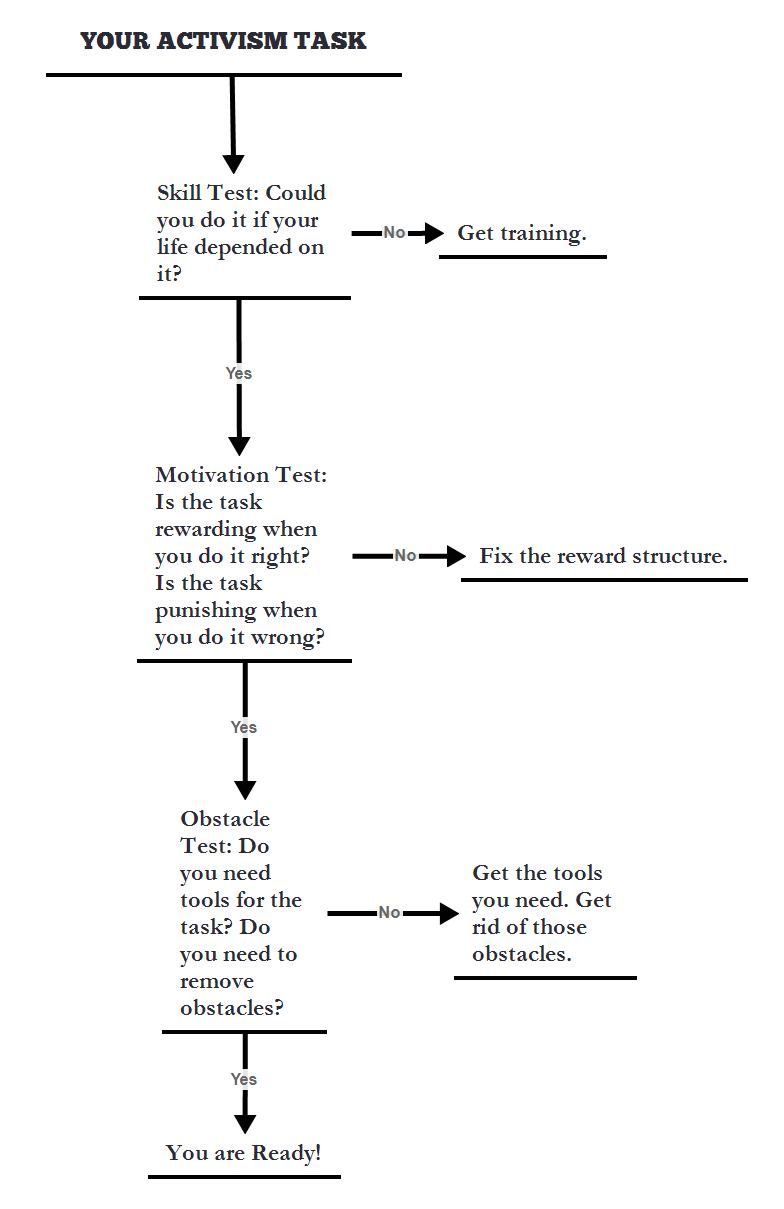- The Meaning of Critical Thinking: A Key Skill for Navigating Today’s Information Landscape - November 3, 2025
- Grandparents Can Develop Activist Grandchildren - September 29, 2025
- Top Six Reasons Credit Union Benefits Are a Smart Choice Over Banks - August 18, 2025
Last Updated on February 27, 2025
How To Make Powerful Change In Your Activism
The key to making powerful change in your activism is setting yourself up for success. That means having the right skills and knowledge, of course. But take two extra steps. First, make sure your work keeps you motivated. Second, remove obstacles that might get in the way of excellent performance.
When I managed a Training Department, we often received requests that went something like this:
I answer the phone.
Bob: “Hi, our department needs to learn German.”
Me: “Let’s see if we can help you. Why do you need to learn German?”
Bob: “We have a new piece of equipment from a German manufacturer, and we can’t read the manual.”
Me: “Okay, let me do a little checking around.”
I call the equipment manufacturer.
Me: “Do you have an English translation of the thingamabob manual?”
Fritz: “Yes, we’ll send it right away.”
I call Bob.
Me: “An English translation is on its way, so you don’t have to learn German.”
Bob: “But we wanted to learn German!”
Successful performance is a mixture of skills, knowledge, motivation, tools, and information. In my job as a Training Manager, I found training was often not the solution to a performance problem. Sometimes it was more about what people wanted or didn’t want.
Bob did not need German to maintain the equipment. In fact, the department had been working on the machine successfully for months, making notes, and basically creating their own manual. Learning German would have worked as a solution, but it was not necessary with the right documentation. The people in Bob’s department wanted to learn German because they would spend their workday not on the harsh factory floor but in an air-conditioned training room, complete with free coffee, lunch, and snacks.
Maximizing Activism Performance
You want to make powerful change in your activism work, so consider all aspects of performance. Set yourself up for success.
Instructional design guru Robert Mager encourages us to take a broad view of performance and how it can be improved.
I’ve adapted his excellent performance analysis worksheet for activists. Here is a framework:
Start with your activism task.
- Skill and Knowledge Test. Can you do the task if your life depends on it?
“No,” means pursue training. If the answer is “Yes,” but you aren’t doing the task, check your motivation. Move to the Motivation Test.
- Motivation Test. Is the task rewarding when you do it right? Is the task punishing when you do it wrong?
The way rewards and punishments are set up in work can affect your motivation. If you get rewarded for doing it right and punished for doing it wrong, you are strongly motivated. But what if you are penalized for doing it right and rewarded for doing it wrong? Change the rewards or punishments that affect your work to make powerful change.
If the answer to the question, “Is the task rewarding when you do it right?” is “No,” then you must change the reward structure.
If the answer to the question, “Is the task punishing when you do it wrong?” is “No,” then you must change the punishment structure.
If the answer to both questions is “Yes,” but you can’t do the task, check for obstacles. Move to the Obstacle Test.
- Obstacle Test. If skill, knowledge, and motivation are not issues, but performance is still a problem, can you get tools or remove obstacles?
If the answer is “No,” then reconsider performing the task at all. Refocus on a different activism task.
If the answer is “Yes,” remove obstacles, get the tools you need, and start!
Activism Example
Jenny is interested in encouraging people to plant more trees to buffer the effects of global warming. She wants to talk to 4th graders about the importance of trees. Then they will plant trees on the school grounds. Finally, she will give each child a seedling to plant at home.
Before she embarks on this activism work, she examines the factors that might impact her performance.
Jenny’s Skill and Knowledge
Jenny is an expert gardener and knows about planting trees and what trees will grow well in her area. She has the knowledge to choose the right trees and the skill to demonstrate the planting process.
Jenny has less skill in presenting information to children, although she has given many presentations to adults. She asks a teacher friend to help her develop her skills in working with children – engaging their interest, handling inattention, and designing an engaging presentation.
Jenny’s Motivation
Jenny’s motivation will be high when she is rewarded for doing the job right. When she sees the kids interested in the information and excited about receiving a tree, she will feel good. That’s a reward.
She will also have high motivation if she is punished for doing it wrong. For example, if she can’t manage behavior, she will be disheartened.
Jenny checks to see if any motivation elements of the situation are backward – – punishing when she does it right or rewarding when she does it wrong.
Is the task punishing when she does it right? She worries that the better her skills at presenting to the kids and handling their behavior, the more the classroom teacher may move on to handle other tasks, leaving her to manage the classroom. That is a compliment, but it makes her work harder. She decides to make the teacher availability a requirement.
Is the task rewarding when she does it wrong? The only thing that is rewarding if she does it wrong is that taking shortcuts will get through the presentation faster. Ultimately, though, if she rushes, she will miss the positive reactions from the kids.
Obstacles in Jenny’s Way
When Jenny considers barriers that might prevent her from doing a good job, she identifies two.
First, her teacher friend gives her a heads up that some kids won’t speak English as their first language. This prompted Jenny to prepare translations of her materials and planting instructions.
Second, Jenny will bring small spades for the kids to use, but she realizes she won’t have a place to clean them before loading it back in the car. She buys a plastic tub for the dirty spades.
Jenny Makes Powerful Change
Jenny’s tree-planting program was successful. She provided presentations in all the city’s 4th-grade classrooms, planting 26 trees and distributing 480 seedlings. She followed up with parents to see if the kids had planted the trees at home and found 65% had. Her evaluation helped her identify obstacles they had encountered at home, such as kids that lived in apartments or rental properties, and improper planting location. The next school year, she offered an option for kids without a yard and updated her instructions with more explicit planting location information.
After two years, Jenny is still feeling motivated about her activism work. In fact, her goal is to train others to continue the work in their school systems. Planting trees in only one step in managing global warming, but Jenny loves that she is making a difference.
[Like what you’ve read? Follow the blog so you don’t miss any content.]
Learn More About Making Powerful Change In Your Activism
- What You Can Do And What You Know Can Change The World
- How to Fix Your Mixed-Up Motivation
- Don’t Let Obstacles Get In The Way Of Your Activism
READ NEXT
Everyone has an ordinary superpower. What is yours? What is Your Superpower?
Mark Henson, the author of Ordinary Superpowers, recommends asking yourself The 6 Questions that Reveal your Superpowers.
In my Getting Started in Activism path, identifying your skills, knowledge, and motivation is Step 2. Learn more. How to Start in Activism – Step 2: What are Your Gifts?





Pingback: What You Can Do and What You Know Will Change the World • Life At the Intersection
Pingback: How to Fix Your Mixed-Up Motivation • Life At the Intersection
Pingback: Don't Let Obstacles Get In The Way Of Your Activism • Life At the Intersection
Pingback: Be Smart: How To Set Activism Goals • Life At the Intersection
Pingback: What Rewards Will You Get Out of Activism? • Life At the Intersection
Pingback: How to Turn Your New Year's Resolutions Into Achievable Goals
Pingback: Quiz: How Does Receiving a Gift Impact How Much You Donate?
Pingback: The Best Gifts For Your Changemaker: Activist Gifts They'll Love
Pingback: At the Intersection of Free Speech and Art: The Talking Statues of Rome